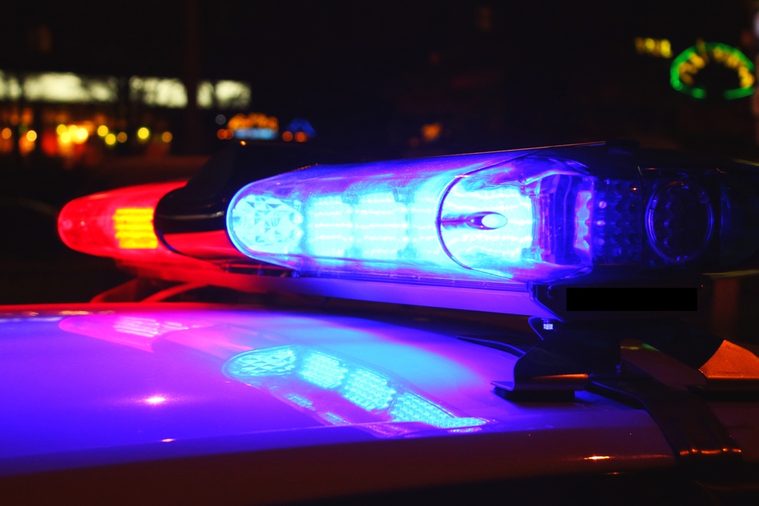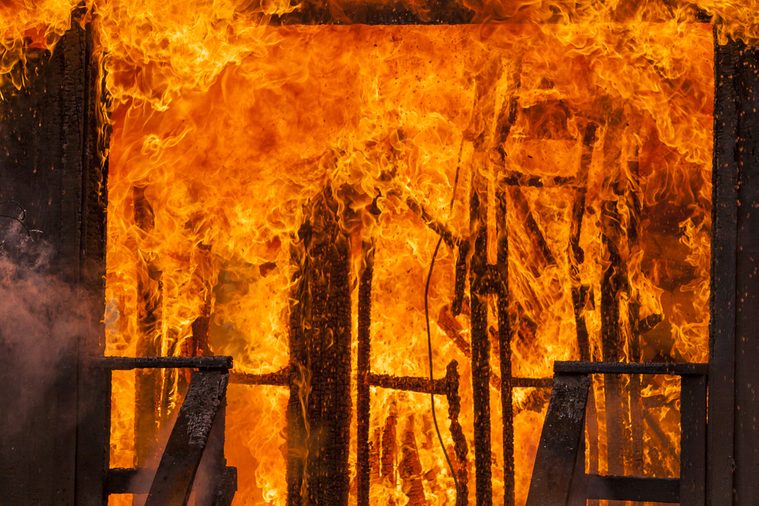
Emergencies happen
While your odds of having a heart attack are much higher than finding yourself in most of these scenarios, strange things happen every day. For example, almost 2.1 million people called poison centers for help in 2018. In 2017, 169,000 people died of injuries from falls, motor vehicle accidents, and other unintentional events. In 2019 alone, more than 5,000 people died from choking in the United States. While 90 percent of people struck by lightning survive, about 27 Americans are killed by lightning strikes every year. How do you keep yourself out of the statistics? Besides calling 911, here’s what to do in life-threatening emergencies when no one’s around to help.

Heart attack
If you’re experiencing crushing chest pain with or without pain in your left arm, are short of breath, or have a sense of impending doom, you may be having a heart attack. (Women are more likely to have atypical heart attack symptoms like severe fatigue, nausea, heartburn, and profuse sweating.) Call 911 and chew one 325-milligram uncoated aspirin to get it into your bloodstream fast. This will thin your blood, stop clotting, and potentially restore blood flow to your heart. While waiting, lie down so your heart doesn’t have to work as hard, says Sandra Schneider, MD, a spokeswoman for the American College of Emergency Physicians. If you think you might pass out, try forcing yourself to cough deeply. It changes the pressure in your chest and can have the same effect as the thump given in CPR, says Dr. Schneider. “Sometimes it can jolt the heart into a normal rhythm.” If someone else goes into cardiac arrest, note that the American Heart Association now recommends CPR without the mouth-to-mouth: Call 911, then push hard and fast on the person’s chest until help comes. Don’t miss these other 8 things that will help you handle a medical emergency.

Lost in the wilderness
Before you head out on a hike, check the weather, take plenty of water, and make sure someone knows where you’ll be and when you’ll be back. Bring clothes to keep you warm when wet, like a water-repellent jacket, says Laurence Gonzales, author of Deep Survival: Who Lives, Who Dies, and Why. Avoid cotton, which traps moisture. “The search-and-rescue people call it ‘death cloth,’” he says. Pack an emergency kit with items such as waterproof matches, a plastic tarp and cord for making a shelter, a blanket, a good knife, a flashlight, batteries, and snacks. Expect to get lost, says John Dill, a search-and-rescue ranger at Yosemite National Park in California. Check constantly to make sure you’re on the trail and stop immediately if you suspect you strayed.
In general, people who try to find their own way out fare worse than those who stay put, says emergency medicine specialist Richard N. Bradley, MD. Find shelter before dark, and try to keep dry. If you’re stranded in your car, stay there: You’re more visible to rescuers, and the car provides shelter. Catch the eye of search parties by making a signal with colorful gear, making a big X out of rocks, or digging a shallow trench, says Dill.
You can go several days without eating, so in most cases, you’re better off not foraging for food, since there are lots of poisonous plants in the wild, says Dr. Bradley. You need to stay hydrated, so if you run out of water, it’s usually better to drink from a stream with suspect water than to go without.

Choking
If you’re ever choking without anyone around to help, you can do a version of the Heimlich maneuver on yourself. Quickly find a chair or other piece of furniture or a kitchen counter, says Maurizio Miglietta, DO, professor of surgery at Touro College. Aim to hit the top of the chair or edge of the counter against your upper abdomen, in the soft part below the bony upside-down V of the ribs. Thrust up and inward. If you still can’t breathe after six tries, call 911 (preferably from a landline, which is easier to track the location of), even if you can’t talk. They’ll find you. Write the word choking somewhere nearby, and leave the line open until help arrives. Learn how to do 10 other medical procedures you can do at home without a doctor.

Impalement
This doesn’t happen only in horror movies. Tornadoes and hurricanes can fling debris for miles, and even recreational hobbies like fishing or archery can be hazardous. If you have something stuck in any body part, including your eye, don’t remove the object, according to the Journal of Emergency Medical Services and the Department of the Navy Bureau of Medicine and Surgery. If you’ve been struck by a branch or some other hefty object, try to trim it, breaking off the part that’s protruding from your body, but don’t pull it out. Seek out emergency treatment. Learn other common first aid mistakes that are seriously dangerous.

Swimming emergencies
Riptide: You know you’re in a riptide when you feel yourself being pulled away from the shoreline, says Dr. Bradley of the Red Cross. “Your natural reaction is to head toward the shore, but it’s very difficult to swim against a riptide.” Luckily, these currents are fairly narrow, so you just have to swim parallel to the beach, in either direction. Eventually, you will make it out of the current. Plus, keep these water safety tips in mind.
Cramps: If you’re in deep water, take a breath, lie on your back, and float. If you’ve got a muscle cramp (they often hit the calves), float facedown, grab your toes, and pull them toward you, stretching your calf until the pain goes away. For a stomach cramp, lie on your back, spread your arms and legs, and float until you can swim back to shore. Make sure you know how to manage these other 10 everyday emergencies.

Bear attack
If you surprise a bear, don’t run away. That invites an attack. Instead, stand up and back away slowly, without looking the bear in the eyes. Speak softly to the animal (no loud shouting), advises the National Park Service. If it does charge at you, try to make yourself look as large as possible: Stick out your chest, raise your arms, and spread your legs. Now you can yell at the bear, to frighten it. If a brown bear or grizzly is going to attack, lie facedown with your hands clasped behind your neck. Play dead and don’t get up; as a very last resort—if the attack persists—fight back with anything at hand. An exception to the “play dead” rule is with black bears: If escape isn’t possible (keep in mind that grizzlies and black bears can climb trees), you should try to fight back concentrating on the bear’s face and muzzle. If you’re in bear country, carry a bear-deterrent pepper spray. Make sure the wind isn’t blowing toward you, and spray for one to two seconds when the bear is 30 to 40 feet away.

Poisoning
The most common reasons for calls to poison centers? Unintentional or intentional drug overdoses (painkillers, sedatives, and antidepressants are high on the list) and exposure to cleaning products. No matter how little you’ve ingested, call a poison center before you do anything. The national number is 1-800-222-1222.
Don’t make yourself throw up or give yourself ipecac, the vomit-inducing antidote that used to be a staple in first-aid kits, which has never been proven beneficial, says Alvin C. Bronstein, MD, the Hawaii health department’s chief of emergency medical services and injury prevention systems. Ipecac can leave you throwing up for hours. Plus, if you ingested something that burned going down and you force yourself to vomit, it will burn on the way back up too.
Colorless, odorless carbon monoxide is a deadly poison that kills nearly 500 unsuspecting people a year. Make sure you have a working detector in your home. If you’ve inhaled something (bleach or ammonia are common culprits), get away from the toxic area. If it’s something that got on your skin, like a cleaning product, wash it off, then call a poison center and follow the specialist’s advice. Find out about 11 household items that are literally poisoning your air.

Severe bleeding
You’re gushing blood—and getting scared. Use your hand or a clean cloth, paper towels, a scarf, or any fabric you can grab, and push down on the wound until the bleeding stops. Tourniquets, which every Boy Scout learned how to make back in the day, are now a first-aid absolute last resort, says Dr. Schneider. “If you have a cut on your upper leg and you put pressure on it, you’re just closing that vessel. But if you put a tourniquet on, you’re going to close the vessels to the entire leg,” she says. “You could lose your foot.” According to the American Red Cross, the only time to use a tourniquet is when applying pressure to the wound with both hands won’t stem the flow. Another reason to use one, says Charles Pattavina, MD, former chief of emergency medicine at St. Joseph Hospital in Bangor, Maine, is when you know that everything below the wound is beyond repair (say, the accident has amputated your finger, arm, or leg).

Rising water
Rule No. 1: Never drive through standing water. What looks like a small puddle can be much deeper. “It takes just 12 inches of water to carry a car away,” says Robert Sinclair, Jr., manager of AAA New York. If you do get stuck, step out of the car, which will likely stall when the water reaches the vehicle’s electronic controls. If the water is higher than the bottom of your knees or is moving too quickly for you to wade through, climb on top of your car and wait for help. Otherwise, get to higher ground.
If you suddenly become immersed (say, you drive off a bridge or into a lake or river), roll down the windows as soon as you can. Yes, it allows water to rush in, but that’s a good thing, says Sinclair. It equalizes the pressure, so you can open the door or swim out the window. Do it quickly, though, as the electrical systems on automatic windows can get damaged and stop working when wet. A LifeHammer can shatter automotive glass and cut through seat belts; Sinclair keeps one between the driver’s seat and the center console in case of such emergencies. Break the side windows (windshields are usually thicker and harder to crack), and swim toward high, dry land.
In a hurricane or storm with heavy winds, hide in a closet or pantry. Don’t try to wade through floodwater outside—it can knock you over. If water is rising in your house, climb to the roof (as long as it’s safe to do so) to wait for help after the heavy rain and wind stop, says Lt. Ana Visneski of the U.S. Coast Guard.

Allergic reaction
Bee stings, food allergies, and medications can be deadly, even if you think you don’t have allergies. Symptoms include itching in one spot or all over your body, sometimes accompanied by a rash, swelling, and, in the extreme, swelling of the airways, which hampers your ability to breathe. If you know you have a life-threatening allergy, form an action plan with your doctor, who will probably prescribe an EpiPen, which comes in child and adult doses. It delivers the drug epinephrine, which keeps the heart pumping, improves breathing, and gives you about 20 minutes to get to a hospital. Even if you don’t have severe allergies, prepare for a spontaneous reaction by slipping a few maximum-strength antihistamines, like Benadryl Allergy tablets, into your wallet. The fast-acting tablets will begin to fight an allergic reaction while you wait for help to arrive. But because antihistamines can make you drowsy, don’t drive yourself to the ER.

Trapped in a burning building
If you’re in an office building and can’t get out, don’t panic. “In any emergency situation, the difference between survivors and nonsurvivors is that survivors remain calm and fight through their fear to find out, What can I do?” says Dr. Schneider. So think back to those fire-safety lessons you learned in grade school. Call 911. Close yourself in a smoke-free room and place a wet towel underneath the door to prevent any smoke from entering, says Dan McBride, a retired New York firefighter. Then get low to the ground, where you can breathe and see better until help arrives. If you’re in a house, get as low as you can and crawl outside as fast as possible. Don’t stop until you’re well away from the fire. Then call for help.
